
by Sture Packalén*
This article was published on 30 November 2005.
Record number of prizes
Within a space of ten years at the beginning of the twentieth century, four writers in German were awarded the Nobel Prize in Literature: Theodor Mommsen (1902), Rudolf Eucken (1908), Paul Heyse (1910) and Gerhart Hauptmann (1912). This is a record that has yet to be surpassed by any other country. The choice of four Nobel Prize Winners from one and the same country in a short period of time may seem strange to us now living as we are in the time of globalisation and with cultural and geographical horizons far different from those existing a hundred years ago. One may, with good reason, wonder whether the Swedish Academy in this respect had not made an interpretation that was counter to what Nobel had in mind when, in his third criterium as to who would be considered for the Nobel Prize, he wrote:”no consideration whatever shall be given to the nationality of the candidates”.
Undoubtedly, the fairly good relations between Sweden and Germany at that time had their own significance in this development. After the founding of the German empire in 1871, Germany became the very pattern and model for Western Europe in matters relating to theology, philosophy, technology, medicine, science, culture and social engineering. German was the language of science and, until the beginning of the 1930s, it occupied roughly the same position in Sweden as English does today. It was not only the members of the Academy who spoke, read and wrote in German, but also the educated Swedish bourgeoisie who, moreover, liked to flaunt their common “Germanic heritage”. The focus on German literature at the beginning of the twentieth century in Sweden was also quite clear. Never have the Swedes read so much German literature – both in the original and translation – as during the first decades of the twentieth century. Of Paul Heyse’s wide-ranging production, for example, there were no less than forty-five of his works that were translated into Swedish; and the more than two hundred works of German literature and other belles lettres found in Alfred Nobel’s private library witness to the self-evident position that German culture held in Sweden at that time. It is hardly overstating the case to say that Sweden, during the period of Kaiser Wilhelm’s government (1888-1918) was culturally a German province.
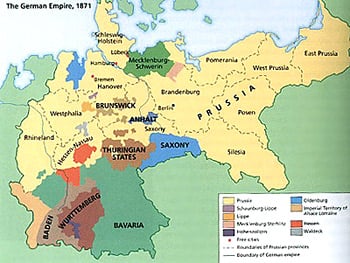
It lies in the realm of probability that these undeniably strong pro-German sentiments had somewhat influenced the Swedish Academy to look towards Germany for authorship which – in accordance with Nobel’s own wishes – was grounded in reality, but ‘in a direction towards an ideal’, and the first three Prize Winners, Theodor Mommsen, Rudolf Eucken and Paul Heyse did precisely this. On the other hand, the fourth prize winner, Gerhart Hauptmann, was their polar opposite in his attempt to describe reality unadorned; however, even his work was eventually caught up in a broader literary stream moving in “an ideal direction”.
Tensions between inner and outer reality
What then was meant by “reality” during the epoch of Kaiser Wilhelm? The discussion around what was considered as reality and the attitude taken towards it was a result of the explosive industrialization in Europe throughout the second half of the nineteenth century. Questions that writers asked themselves were: what is the relationship of external reality – a reality that is independent of our consciousness – to our inner reality? How can the tensions between objective ‘mirroring’ and subjective interpretation of reality be resolved in the fictions of literature? Is it at all possible to resolve these tensions and to capture an increasingly complex reality with the traditional linguistic and stylistic means at our disposal? The answers to these questions about reality were many, but in Germany they tended to posit the idea of an evolving harmony, a movement towards equilibrium between the two poles of an objective reality and subjective human consciousness. The work of Mommsen, Eucken and Heyse was characterized by this spirit of willingness to see reality in an explicable, idealised light, whereas Hauptmann, the consumate naturalist, rejected all attempts to embellish reality. Like other naturalists he adopted a critical position, under the banner of “truth”, towards hypocrisy and convention and under the banner of “modernity”, towards the fashion for historical themes and subjects within literature. It is in the light of this dichotomy between the idealised and the naturalistic view of reality that we should also consider these first German literary Prize Winners and their work.
Equally important in this context is the fact that the industrial revolution in Germany had brought with it a pragmatic way of thinking. This meant that profits and material success were more important than ethical principles and fundamental philosophical questions. This gave rise to a crisis within the educated bourgeoisie which had been nurtured by Goethean ideals of the good, the true and the beautiful, as the basis for the harmonious personality. Without a stable internal ethical compass and increasingly being subjected from without to the demand to ‘succeed’, this generation tried at all costs to maintain an outwardly respectable facade and to deny the conflicts, ugliness, passions and subconscious urges of the psyche. One way of doing this was, on the one hand, to depict the successful lives of the bourgeoisie in a positive light and, on the other hand, to look back to times past when the great and the good were able to display themselves in all their glory.
Lively backward glance at Roman times
The last mentioned road was the one taken by the first German Prize Winner, Theodor Mommsen. Mommsen was in fact not a fiction writer at all but rather a lawyer, historian and philologist – but in all of these roles he was a supreme stylist. He had one foot in the stream of Romanticism and the other in the so-called Gründerzeit (the years of rapid industrial expansion) when a number of large companies were founded by forceful individuals in Germany. Mommsen himself was what we would call today an entrepreneur, an ambitious and hard-working scholarly organizer who, full of heroic energy, brought to full fruition his scholarly project. The work that made the young and unknown Mommsen famous among his contemporaries was the monumental The History of Rome (1854-1885; Römische Geschichte), a work that is still regarded with respect for its solid scholarship even though it is marked by Mommsen’s own politically liberal views and an obvious idealisation of Caesar. The History of Rome first appeared in three volumes which describe the rise of the Roman Empire from its beginnings and up to the Battle of Thapsus (46 B.C.). A planned fourth volume which was to deal with the time of the Caesars was never published. Eventually, however, the fifth volume entitled The Provinces of the Roman Empire from Caesar to Diocletian (1885; Die Provinzen von Caesar bis Diocletian) appeared in print; this volume covered the first three hundred years of the Roman provinces under the Caesars. With an unprecedented combination of knowledge, concreteness, intuition and poetic talent Mommsen succeeded in bringing Roman history to vivid life and even, literally, to make the old stone inscriptions speak to his contemporaries and perhaps also to us. The words of C.D. Wirsén, Permanent Secretary of the Swedish Academy, about Mommsen’s The History of Rome bear witness to the fact that it made an enormous impression at the time it came out: “It is a monument which, though it may not possess the soft beauty of marble, is as perennial as bronze”. (Presentation Speech by C.D. af Wirsén, Permanent Secretary of the Swedish Academy, on 10th December 1902).
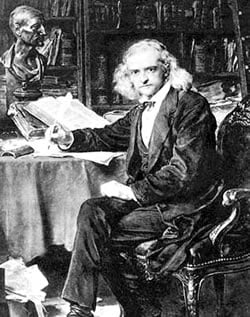 |
| Theodor Mommsen at his writing table. |
The soul in a world bereft of harmony
The work of philosopher Rudolf Eucken, however, was less a monument and more a document of its time in that it tried, from an idealistic standpoint, to give answers to the question of the place and role of humanity in the world. His philosophy was based on the notion, central to German idealism, that the soul is the origin of everything, indeed the force that holds together the whole of existence in harmonious unity. Symptomatic of this outlook is his philosophical dissertation Life’s Basis and Life’s Ideal: The Fundamentals of a New Philosophy of Life (1907; Grundlinien einer neuen Weltanschauung). Here, as in all his writings, Eucken discourses on the disharmony of the modern world. Eucken considered that science and technology, and even intellectualism and aestheticism are stumbling blocks for the development of humankind’s spiritual life. Humanity, according to Eucken, is the meeting place of nature and spirit. For this reason, it is the duty of humankind to raise itself above its physical existence in order to become part of a higher spiritual life. According to Eucken, the human soul is what sets human beings apart from the rest of creation, and he denies that the soul has anything to do with causal relationships in nature or social life. The contrast to aggressive naturalism could not be clearer. Thus it was hardly surprising that the educated German middle class, which in the period before and just after the First World War felt threatened from within and without, should find in Eucken a prophet of their time.
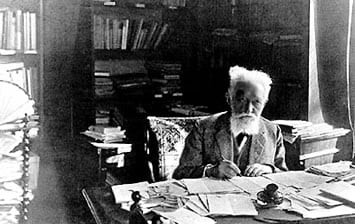
Rudolf Eucken at his working table.
A poet king and his “gilt-edged poetry”
The tradition and ideas of German idealism, with its roots in Goethe’s time, was fundamental not only for the German middle class during the latter half of the nineteenth century, but also for many writers. The industrialized world seemed increasingly alien and incomprehensible to many people. Disillusionment about this caused many writers to turn their backs on their own time and retreat into the stylistic literary world of the Weimar classics and German Romanticism. In literature Paul Heyse was one of these.
Heyse, together with Emanuel Geibel and others, was one of the so-called “Munich poets’ circle” (Münchner Dichterkreis) which gathered around the art-loving king of Bavaria, Maximilian II. Several times a week, Maximilian gathered around him poets, scientists and courtiers at an informal meeting where lectures, readings and criticism of new poems and other literary works were given. These ‘court’ writers wrote in a spirit of protest against the times they were living in, but the literature they produced was not ‘novel’ but rather formally polished craftsmanship, a kind of “gilt-edged” poetry whose form was more important than its content.
Heyse was a true poet king and cultural aristocrat, but he was also one of the German people’s favourite authors and in that role he took up the mantel of Goethe in the German folk consciousness. His books were published in such enormous numbers and so many different editions that they actually competed against one another in the book-shops. “That sunnily amiable and almost indecently fertile epigone” as Thomas Mann called him, was a man who was a literary virtuoso in all the genres. Apart from poetry, Heyse also wrote about 70 plays and a number of novels. His most important, and to this day, eminently readable, contribution to literature was his more than 150 short stories. He achieved fame with his very first short story The Fury (1855; L’Arrabiata). With its lucid language, its dramatic structure, its sensual undertones and its colourful description of the Italian landscape, the story was just what the well-off members of German society wanted to read.
Heyse’s firm conviction that literature should regard the real world “in an ideal light that would transform reality” made him the sworn enemy of naturalism. The naturalists for their part subjected him to merciless criticism, indeed to an “iconoclastic attack” since he, on account of his pronounced aestheticism, drew a veil of incomprehension over the burning social questions and social ills of the time. (Presentation Speech by C.D. af Wirsén, Permanent Secretary of the Swedish Academy, on 10th December 1910).
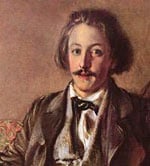 |
| Portrait of the young Paul Heyse. |
Standard bearer of naturalism
The stink of backyards, overcrowding, fleas and alcoholism, and all the social misery and oppression that Heyse preferred not to see now made its debut in German literature with the advent of naturalism. In the spirit of Darwin and science, humankind came to be regarded as a product of inheritance and environment. To the more fortunate in German society talk of bad, inherited, social conditions was both uncomfortable and irritating.
Thus, when Gerhart Hauptmann’s play Before Sunrise (1889; Vor Sonnenaufgang) was staged in Berlin with almost brutally naturalistic consequences, it caused one of the biggest scandals in German theatrical history. Amidst the uproar, screams and fighting, enthusiastic supporters and opponents came to blows and the performance had to be interrupted a number of times. In the play, a man abandons his betrothed when he learns from a doctor that she is suffering from a genetically transmitted alcoholism, and she eventually commits suicide. Hauptmann highlights a tragic conflict which is based on naturalism’s “scientific” knowledge of humankind. The topicality of the drama as well as its reforming spirit and unvarnished realism and depiction of humanity put Hauptmann in the forefront of German naturalism. The critics, however, were not kind. He was dubbed “a talent in dirty clothes” and “the most indecent playwright of the century”. Only the old poetic realist, Theodor Fontane, who helped many young authors take their first steps up the ladder, saw that Hauptmann was breaking new ground and paid homage to him in a review.
While in his first play Hauptmann had the proletarian mine workers as a backdrop to the plot, in his masterpiece, the collective drama The Weavers (1892; Die Weber) the misery of the exploited weavers and their rebellion in 1844 is the central theme. The Weavers, a play with a social purpose, is full to overflowing with indignation and compassion. The protagonist is not a single individual but the collective, the proletariat. The subject was so controversial in Germany at the time that at first its staging was forbidden and later, when it was permitted, Kaiser Wilhelm ostentatiously demonstrated his displeasure by cancelling the royal box at the Deutsches Theater.
However, the naturalist revolt which was spearheaded by Hauptmann was of short duration in Germany. It is characteristic of Hauptmann that he very soon began to write pieces in a more symbolist style, for example, the fairy-tale dramas Hannele (1893; Hanneles Himmelfahrt) and The Sunken Bell (1896; Die versunkene Glocke). These plays were eminently suitable to the ‘new’ romanticism of the turn of the century literature and resonated well with the governing classes who were now even able to look with forgiveness on Hauptmann’s naturalistic works. Probably, the Nobel Prize of 1912 should also be seen in this light. In his well-written presentation speech the then Permanent Secretary of the Swedish Academy, Hans Hildebrand, emphasised the new romanticist and symbolist elements in Hauptmann’s writing. He also mentions the remodelling of society which Hauptmann’s dramas strongly indicate, but he totally avoids the word “naturalism” and calls Hauptmann rather “a marked realist”, adding the important message: “One cannot deny the existence of the seamy side of life, and it must have its place in literature in order to teach wisdom to the living.” (Presentation Speech by Hans Hildebrand, Permanent Secretary of the Swedish Academy, on 10th December 1912).
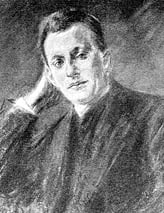
A sketch of Gerhart Hauptmann.
Conclusion
The Nobel Prizes in Literature which were awarded to the German writers Mommsen, Eucken and Heyse in the first decade of the twentieth century highlighted, above all, authors who looked towards the past and who presented an idealised picture of reality informed by the good, the true and the beautiful. The prize awarded to Hauptmann, on the other hand, was a tribute to naturalism’s inexorable depiction of industrial society. In many ways, one can see the attention paid to these works and authors as a direct reflection of the way in which society and literature were developing in the whole of Europe before and around the turn of the century, but perhaps above all – as indicated above – as a clear expression of the close ties which then existed between Sweden and Germany, when Germany was regarded as the role model and cultural blueprint.
Editor’s note:
The photographs appearing on this article are believed to be part of the public domain, unless information to the contrary is provided. Proper notification will be made of existing rights as soon as they come to our attention.
* Sture Packalén is professor of German at Mälardalen University in Sweden. He started out as a student of German literature at the University of Uppsala, Sweden and University of Konstanz, Germany and also at the University of California Davis, USA. In 1986 he gained his Ph.D. for a thesis entitled Zum Hölderlinbild in der Bundesrepublik und der DDR at Uppsala University. He has been employed by the Akademie der Künste in Berlin to take care of the literary remains of Peter Weiss; he has also been a research fellow for The Swedish Council for Research in the Humanities and Social Sciences (HSFR) and assistant professor at the University of Uppsala. Since 1988 he has had the chief responsibility for German language literature for the Swedish National Encyclopaedia, Nationalencyklopedin. He is a member of the board of the Zentrum für Deutschlandsstudien in Stockholm. Sture Packalén has published several literary articles in the field of modern German literature. He is the author of a number of textbooks, among others an introduction to the history of German literature, Literatur und Leben, 2002.
First published 30 November 2005